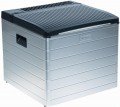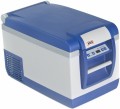Principle of operation
The principle of operation of an car refrigerator, in other words, the cooling method used in it.
—
Thermoelectric (Peltier). Cooling using thermoelectric plates, so-called. Peltier elements. When current is passed through such a converter, one side of the plate is cooled, and the other side is heated. Thanks to this, in car refrigerators of this type, it is possible to implement not only cooling, but also heating (see "Operating modes"). Compared to compressor refrigerators, thermoelectric systems are much simpler, more reliable, more compact and cheaper. On the other hand, with higher power consumption, they have lower performance. And the efficiency of Peltier elements is not very high — in particular, they do not cool to a certain temperature, but to a certain number of degrees relative to the ambient temperature (usually 10 – 15 °C).
—
Absorption. Absorption refrigerators are known as devices that can operate not only from electricity, but also from a gas cylinder. The principle of their operation is based on the absorption of ammonia by water and the heating of the water-ammonia solution with a heater; the heater can be either electric or gas. Accordingly, one of the main advantages of such models is independence from electricity. This is especially true when used outdoors, especially since the gas consumption is very low — for example, a 5-liter cylinder can last for almost 10 d
...ays of continuous operation. At the same time, in terms of speed and overall cooling efficiency, such models are noticeably superior to thermoelectric ones, although they are inferior to compressor ones. On the other hand, the design of the absorption car refrigerator is quite simple, and the noise level is low. The volume of such units can be quite impressive — up to 100 liters or more.
— Compressor. Similar models use the same principle of operation as conventional home refrigerators. The compressor "drives" the refrigerant through the refrigeration circuit between the evaporator and condenser; cooling occurs due to the evaporation of the refrigerant, then excess heat is discharged to the outside through the condenser heat exchanger. This principle of operation is considered the most effective: compressor car refrigerators very quickly gain operating temperature and perfectly cool the contents, it is quite possible to provide freezing in them, and the volume of such a unit can be almost any. On the other hand, compressor systems are quite complex and expensive, they do not tolerate shocks and shaking, and they also require a constant power supply, which can create inconvenience during long field trips.Volume
The volume of the working chamber of the car refrigerator. The larger the volume, the more products can be loaded into the unit at a time. When choosing according to this parameter, it makes sense to select a model with a margin, because it is not recommended to load products too tightly — this adversely affects the quality of the device. On the other hand, note that the volumetric container and dimensions will have the appropriate ones.
Number of chambers
The presence in the refrigerator of separate zones for storing products, separated by a stationary dense wall of a non-removable structure. The vast majority of car refrigerators have a
single-chamber layout, however, there are also
two-chamber models, which is extremely convenient for sorting products.
Operation mode
—
Cooling. A mode of operation in which the food placed inside is cooled to a temperature just above zero (the minimum threshold is usually around 4 °C). Present in all car refrigerators by definition.
—
Freeze. An operating mode designed to cool the food placed in the cooking chamber to a temperature below zero (in some models down to -18°C). In some models, it can also be used for making ice in special compartments.
—
Heating. The mode of operation for heating products is especially useful in the cold season. Many models with this function have fairly good heating characteristics, allowing you to heat food in them to a hot state. This mode is also good for keeping food hot. However, car refrigerators with a heating function are usually quite expensive.
Min. cooling temperature
The minimum temperature to which the refrigerator is able to cool the product placed in it when operating in cooling mode. It should be taken into account that the minimum cooling temperature is not always achievable in fact: the actual cooling temperature depends on the ambient temperature and on the capacity of the refrigerator for maximum cooling (for more details on the calculation formula, see "Maximum cooling per (°C)"). However, this applies only to refrigerators that are not equipped with compressors (see Compressor);
compressor models are able to reach the minimum cooling temperature regardless of external conditions.
Сooling energy consumption
The power consumed by the refrigerator when operating in cooling mode. The greater this power, the more performant the refrigerator is, usually, and the less time it takes to cool the product. On the other hand, note that more power means more power consumption — which can be critical, for example, during long-term operation from a car battery (that is, when the car engine is turned off).
Features
—
USB for charging gadgets. A standard USB port that can be used to charge a smartphone or other gadget. Note that this function only works if the refrigerator is connected to the power grid — car refrigerators do not have their own batteries, and without an external power source, no energy will be supplied to the USB port.
—
Smartphone control. The ability to control the unit from a smartphone or other gadget, usually through a special application. The gadget itself is connected directly wirelessly, via Wi-Fi or Bluetooth. This function provides a number of conveniences. Firstly, it allows you to control the operation of the refrigerator from a distance. Secondly, the application on the smartphone is often more convenient and visual than the unit's own control panel. Thirdly, the gadget can receive various notifications from the refrigerator: settings, current status, notifications about malfunctions, etc. At the same time, control from a smartphone is not cheap, which is why it is quite rare, mainly in fairly advanced models.
—
Built-in fan. The presence of a fan in the working chamber of the refrigerator. Due to this function, improved air circulation inside the chamber is ensured, which contributes to better and more uniform cooling of the loaded products.
—
Battery discharge protection. A car refrigerato
...r with this function constantly monitors the battery condition when operating from a car battery (with the engine off). If the charge drops to a critical level, the unit “takes action”: it switches off automatically or signals the need to switch off. This allows you to avoid a complete battery discharge and unpleasant situations such as the need to start the engine “by pushing”.
— Interior lighting. The presence of internal lighting in the working chamber of the refrigerator. This makes it easier to use in low-light conditions — even in complete darkness outside, the contents of the chamber can be easily seen.
— Cup holder. Cup holders are typical indentations in the lid: a cup, bottle, or another container with liquid can be placed in such an indentation without fear of it tipping over.
— Bottle opener. A tool for opening glass bottles with metal caps that do not have threads. It is usually implemented as a built-in metal element on one side of the housing.
— Removable lid. The ability to remove the refrigerator cover from the main container. The meaning and features of this function may be different. So, in some models, the cover is removed only to make it easier to get to the contents and to make it easier to wash/clean the working chamber. In others, it may be possible to choose the side to which the cover will be folded. And some units with this function are equipped with two lids at once: one has a power cord and a cooler, when installed, the device functions as a refrigerator, the second is a simple heat-insulating cover that turns the car refrigerator into a thermos.
— Carrying strap (on the shoulder). Special strap that allows you to carry the device like shoulder bag. In fact, this function is most often equipped with bag models (see "Type"). In any case, such a strap significantly simplifies transportation: it is more convenient to carry a fairly heavy refrigerator on your shoulder, and your hands remain free. There are even models that can be carried like regular backpacks.
— Transportation wheels. The ability to transport car refrigerators like a cart is much more convenient than carrying them in your hands or on your shoulder, especially with large volumes and the corresponding weight of the model.Display
Own external display. Various service information can be displayed on such a
display, such as the temperature inside the working chamber, the operating mode enabled (see "Operating mode"), the battery charge level (see "Battery status control"), etc. The display makes the management of the refrigerator more visual and simple — in particular, it allows you to control the status of the contents of the working chamber without opening it.

